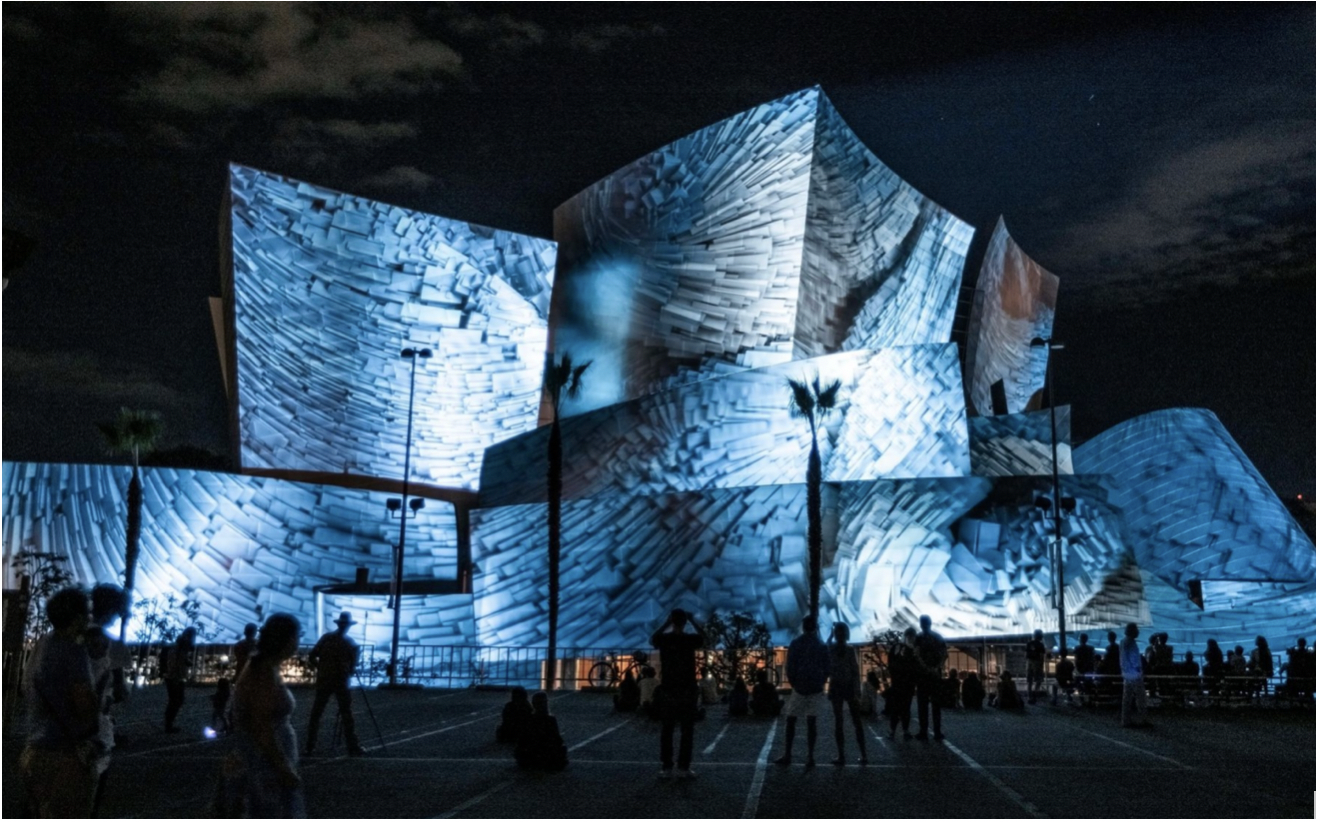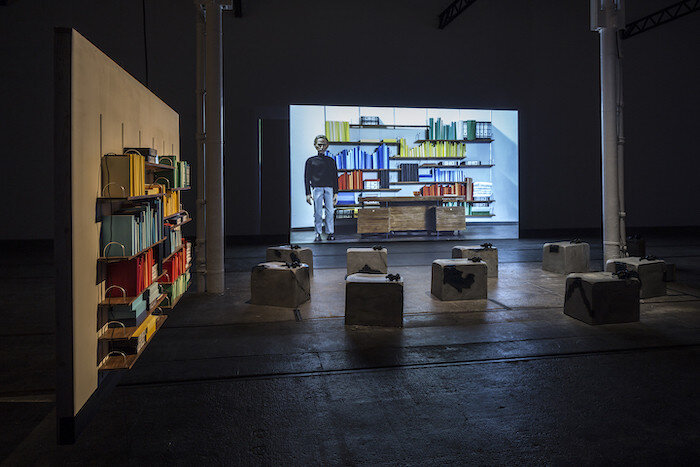Walt Disney Concert Hall Dream
WDCH Dreams is a media installation created by Refik Anadol to celebrate 100 years of the Los Angeles Philharmonic. Anadol uses 42 projectors installed around the perimeter to display forty-five terabytes of data. This data includes images and videos that are projected onto the silver building. The curved shape of the Walt Disney Concert Hall allows for the projections to have a textured look and also allows for a 360-degree experience. The projections are sometimes one cohesive image/video and other times include multiple related images displayed against the building. As the installation is interactive, each night and every half hour, the performance could be different depending on how the audience interacts with the touchscreen interface inside. Celebrating the 100 years of history tied to the LA Philharmonic is both individual for the person at the screen and collective for other visitors or passing individuals.
The building itself is made of stainless steel and gives the appearance of sails. The curved shape allows for playful interaction with the viewer’s eye. Frank Gehry, the architect, designed the building with the whimsicality to match his love for sailing. Much like his other works, the Walt Disney Concert Hall uses unique patterns of architecture that defy traditional styles of squares and rectangles and even gravity. He was licensed to build the concert hall in the late 1980s, but it was not finished until 2003. Once finished, the building became a space for a multitude of different types of art beyond music, apparent with this installation.
Courtesy of the artist: http://refikanadol.com/works/wdch-dreams/
The installation took place from September 28th to October 6th, 2018 and displayed different images and videos from 19:30 to 23:30 every night. Trying to mimic the way humans dream, Anadol uses artificial intelligence to interpret the archive in the same way that humans interpret experiences in their dreams. He does this by working with Parag K. Mital, a researcher for Google Arts and Culture. “Together, they create something new in image and sound by awakening the metaphorical “consciousness” of Walt Disney Concert Hall” (refikanadol.com). WDCH Dreams explores this consciousness in three parts:
““Memory,” “Consciousness,” and “Dreams”—each showcasing various aspects of a computer- conceived interpretation of data from the LA Philharmonic’s immense archives, processed via the space of the building itself. As Anadol sees it, it is as if the concert hall itself is doing the remembering, the thinking, and the dreaming”
Hope is also a key part of this installation as hope is important to the future of artificial intelligence and to the LA Philharmonic as they are using their history to look into their future.
Courtesy of the artist: http://refikanadol.com/works/wdch-dreams/
Looking into the history of the artist, born in Istanbul, Turkey, Anadol is currently a lecturer and researcher for UCLA in their Department of Design Media Arts. He is based in Los Angeles and received two Masters of Fine Arts: the first in visual communication design from Istanbul Bilgi University and the second in media arts from UCLA. He created Antilop, a group dedicated to creating audio-visual and interactive installations. His focus is to explore and create spaces that have digital and physical properties through architecture and media arts. Machine intelligence is also a large component as he offers the public alternative realities and uses architecture to show that any space can be used for digital media. This is especially relevant to WDCH Dreams as it uses the building as the platform for this alternative understanding of the archive.
Focused on the data universe, the materials used in the installation are crucial to the meaning behind the artwork. The affect and reactions created from his work are important to Anadol. By using 42 projectors with 50K resolution and 8-channel sound, he can project the images and handpicked soundtrack outside the concert hall with incredible quality. Creating new architecture and embedding media arts into this changes the space in ways unimaginable, which is his goal for all his work.
Courtesy of the artist: http://refikanadol.com/works/melting-memories/
Anadol also uses the concept of space and history in his piece Melting Memories. Here, architecture and light projections are used portray motor movement from inside of a brain. Like the projections used in WDCH Dreams, the projections in Melting Memories are a way for the individual to see a physical manifestation of a human process. How this piece differs is its focus on neural mechanisms instead of images. The installation uses information from the University of California Neuroscape Laboratory. He uses the quote “science states meanings; art expresses them” by philosopher John Dewey to explain his connection of advanced technology and modern art (Refik Anadol, 2018). Memory retrieval is important to both humans and data, a quality represented in both of these projects.
Like Anadol, Lauren Lee McCarthy is an artist based in Los Angeles also interested in AI. Creator of p5.js, she is passionate about examining social relationships within our current digital and AI culture. Specifically, through her project Lauren, she explores the relationship between human-human and human-machine by trying to create a human personification of the Amazon Alexa. She fills the ambiguous space between the two categories by controlling all facets of a participants home. She aims to be more comprehensive than traditional AI because she can better understand the needs and desires of the person. While the specific style of relationships that McCarthy explores are different than Anadol, both artists are intrigued by ambiguous space and relationship with technology. WDCH Dreams and Lauren both try to capture a human process but in contradictory ways; the former uses this process and makes it digital while the latter uses the digital and makes it a human process.
Courtesy of the artist: https://lauren-mccarthy.com/LAUREN
Artificial intelligence is growing increasingly relevant and important to modern digital and human culture around the world. Art, technology, and the human experience are becoming more intertwined as they rely on technology on a daily basis. Anadol heavily explores this idea in many of his projects. With digital devices constantly within arm’s reach, the way individuals occupy and use space is ever changing. Dreams are a whimsical concept that Anadol is able to harness and interpret through a technological lens, something our brains already do as Cyborgs.
Donna Harraway introduces the idea of the Cyborg in her 1985 book, A Cyborg Manifesto. In this text, she explores difference in humankind and how humans and technology cannot be separated. Anadol also focuses on difference and our environment. By celebrating and learning from our history, we can move forward praising difference rather than separating because of it. WDCH Dreams is a physical manifestation of this concept: using the history of the establishment to create the concert hall as a place for everyone.
Using multiple widely successful artists and researchers to create WDCH Dreams in conjunction with the free price tag allowed this piece to be a huge success. Because of the large media platform of the building itself, even those not attending the event are still able to enjoy and react to the art in front of them. The installation on the inside also allows for the experience to go beyond the outside performance. The Ira Gershwin Gallery showcases the entire archive and visitors can view the timeline of the 100 years at their fingertips. A simple search in Google will show how successful the installation was with a plethora of articles praising the creativity and artistry to celebrate the Walt Disney Concert Hall.
Courtesy of dezeen: https://www.youtube.com/watch?v=DdZClLG0g0I
References:
Anadol, Refik. “About.” Refik Anadol. http://refikanadol.com/about/ (March 8, 2020)
Anadol, Refik. “Meltin Memories.” Refik Anadol. http://refikanadol.com/works/melting-memories/ (March 10, 2020)
Anadol, Refik. “WDCH Dreams.” Refik Anadol. http://refikanadol.com/works/wdch-dreams/ (March 8, 2020)
Gibson, Eleanor. “Frank Gehry's Walt Disney Concert Hall illuminates with dream-like visuals.” dezeen. https://www.dezeen.com/2018/10/04/frank-gehry-walt-disney-concert-hall-dreams-projections-refik-anadol/ (March 8, 2020)
Huewe, Kyle. “REFIK ANADOL | “WDCH DREAMS.” Flaunt. https://www.flaunt.com/content/refik-anadol (March 10, 2020)
McCarthy, Lauren L. “Lauren.” Lauren Lee McCarthy. https://lauren-mccarthy.com/LAUREN (March 10, 2020)
“WDCH Dreams.” LA PHIL. https://www.laphil.com/visit/when-youre-here/wdchdreams (March 10, 2020)









